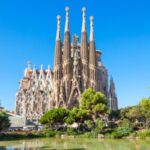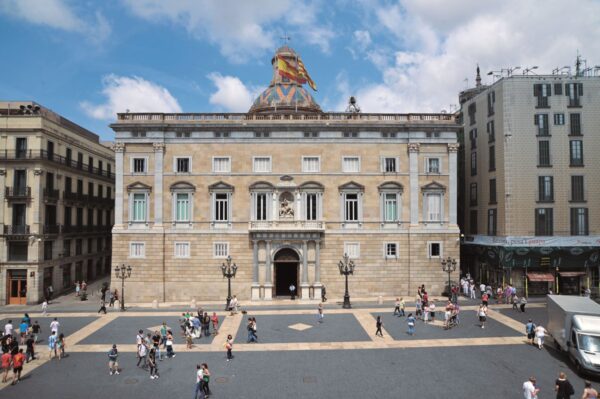
Barcelona, a city renowned for its rich history and stunning architecture, offers visitors a unique blend of the old and the new. Among its many treasures, the Barcelona Cathedral stands as a magnificent example of Gothic design, while Plaça Sant Jaume serves as the heart of the city's political and administrative life.
For those looking to immerse themselves in the cultural essence of Barcelona, Explore Barcelona Cathedral and Plaça Sant Jaume provides an unforgettable experience. The cathedral's intricate details and the vibrant atmosphere of the square invite exploration and discovery, making it a must-visit destination for any traveler.
Explore the Majestic Barcelona Cathedral: A Historical Overview
The Barcelona Cathedral, officially known as the Cathedral of the Holy Cross and Saint Eulalia, is a masterpiece of Gothic architecture that dates back to the 13th century. Its construction took nearly 150 years, reflecting the city’s devotion to religious architecture. Visitors can admire stunning elements such as the neoclassical façade and the intricate spires that dominate the skyline of the Gothic Quarter.
One of the cathedral's most remarkable features is its imposing interior, which boasts a stunning nave and a series of chapels adorned with beautiful stained glass. The cathedral also houses the tomb of Saint Eulalia, the co-patron saint of Barcelona, making it a significant pilgrimage site. Additionally, the rooftop offers breathtaking views of the city, providing a unique perspective on the surrounding architecture.
Surrounding the cathedral, visitors will find a vibrant atmosphere enriched by the historical significance of the area. Key points of interest include:
- The serene cloister, home to 13 white geese, symbolizing the age of Saint Eulalia.
- Fascinating artworks that span centuries, reflecting the evolution of religious iconography.
- The nearby Plaça Sant Jaume, a hub for important political events and ceremonies.
In summary, exploring the majestic Barcelona Cathedral not only offers insights into the city’s architectural heritage but also connects visitors with its deep-rooted cultural history. This iconic landmark stands as a testament to Barcelona's enduring spirit, making it an essential part of any itinerary.
Unveiling the Architectural Wonders of Barcelona Cathedral
The architectural wonders of Barcelona Cathedral captivate visitors with their intricate details and historical significance. Built on the site of an early Christian church, the cathedral is a masterpiece that showcases the evolution of Gothic architecture throughout its construction period. The combination of stunning spires, ornate façades, and elegant flying buttresses makes it a prime example of the style that defined a significant era in Barcelona’s history.
Stepping inside, visitors encounter a breathtaking interior that seamlessly blends grandeur with serenity. The cathedral features a magnificent nave that leads to a series of chapels, each adorned with exquisite stained glass windows illuminating the space with vibrant colors. Notably, the presence of the tomb of Saint Eulalia adds profound spiritual significance, further enriching the cathedral's allure.
Surrounding the cathedral, the cloister is a tranquil retreat adorned with lush gardens and elegant arches. Here, guests can observe the famous 13 geese that symbolize the age of Saint Eulalia, creating a connection to the legend and history of the site. Additionally, the nearby Plaça Sant Jaume enhances the experience, as it serves as the backdrop for significant civic events, linking the sacred and the political in one vibrant area.
In essence, exploring the architectural wonders of Barcelona Cathedral is not just about admiring its aesthetic beauty but also about understanding its role in the cultural fabric of the city. This magnificent landmark remains a vital part of Barcelona’s identity, inviting visitors to delve into its rich past while enjoying the lively atmosphere of the surrounding area.
The Significance of Plaça Sant Jaume in Barcelona's History
Plaça Sant Jaume holds a pivotal role in Barcelona's history as the administrative heart of the city. This square has been the site of numerous significant events, from ancient Roman gatherings to modern-day political demonstrations. As the intersection of the Gothic Quarter and the Ciutat Vella, it symbolizes the continuity of governance throughout the centuries.
The square is flanked by two important buildings: the Palau de la Generalitat, the seat of the Catalan government, and the Ajuntament de Barcelona, the city hall. These structures embody the blend of historical and contemporary architecture, representing the evolution of Barcelona's political landscape. Key historical milestones at Plaça Sant Jaume include:
- The signing of important treaties and laws.
- Significant political protests advocating for Catalan autonomy.
- Cultural celebrations and public events that reflect the city's vibrant community spirit.
Throughout history, Plaça Sant Jaume has served as a gathering point for citizens, fostering a sense of unity and civic pride. Its transformation from a Roman forum to the current-day political epicenter highlights its enduring significance. Visitors can feel the weight of history in the air, making it a crucial stop for anyone wishing to understand Barcelona's past and present.
Today, the square is not only a historical landmark but also a lively space where locals and tourists alike come to enjoy its atmosphere. Street performances, markets, and festivals take place regularly, further enriching the cultural tapestry of the area. Thus, Plaça Sant Jaume remains a testament to Barcelona's ongoing narrative, binding together its rich heritage and dynamic future.
A Guide to Experiencing Barcelona Cathedral and Plaça Sant Jaume
Visiting the Barcelona Cathedral and Plaça Sant Jaume offers a unique glimpse into the city’s rich history and vibrant culture. As you approach the cathedral, the stunning Gothic architecture captivates with its intricate details and soaring spires. The serene atmosphere inside provides a perfect setting for reflection, while the rooftop offers a panoramic view of the surrounding Gothic Quarter, making it an ideal starting point for your exploration.
After soaking in the majesty of the cathedral, take a leisurely stroll to Plaça Sant Jaume. This historic square not only serves as a focal point for political activity but is also a gathering place for locals and tourists alike. The square is surrounded by significant buildings, including the Palau de la Generalitat and the Ajuntament de Barcelona, both of which reflect the city's architectural evolution. Key aspects to enjoy in the square include:
- The lively atmosphere, often filled with street performers and public events.
- Historical plaques detailing the importance of the area.
- Art installations that add a modern touch to the historic setting.
Engaging with Plaça Sant Jaume allows visitors to appreciate the dynamic relationship between history and contemporary life in Barcelona. The square has witnessed countless historical moments, from ancient Roman gatherings to modern-day protests, making it a living testament to the city’s vibrant spirit. Here, you can feel the pulse of Barcelona as locals convene to celebrate cultural events or engage in civic discourse.
In summary, a visit to the Barcelona Cathedral and Plaça Sant Jaume is not merely a sightseeing trip; it is an opportunity to connect with the heart of Barcelona's history and culture. Whether you're admiring the stunning architecture or participating in the lively activities of the square, these landmarks promise a memorable experience that encapsulates the essence of the city.
Cultural Events and Activities at Plaça Sant Jaume
Plaça Sant Jaume is a vibrant hub for cultural events and activities, attracting both locals and tourists throughout the year. This historic square is often the backdrop for various public celebrations, including festivals that highlight Catalan traditions. Visitors can witness events like the annual La Mercè Festival, which showcases music, dance, and colorful parades, making it a lively cultural experience.
In addition to festivals, Plaça Sant Jaume hosts regular open-air markets where artisans and local vendors showcase their crafts. These markets not only provide a platform for local talent but also offer a unique opportunity for visitors to engage with the community. The atmosphere is enriched by street performers and artists who frequently entertain passersby, creating a lively and dynamic environment.
The square is also a significant site for political and civic engagement, often serving as a stage for protests and public discussions. These events reflect the city's rich history and ongoing dialogue about local issues, allowing visitors to gain insight into contemporary Catalan culture and politics. Regular activities such as art exhibits and cultural presentations further emphasize Plaça Sant Jaume's role as a center of community engagement.
Overall, the cultural events and activities at Plaça Sant Jaume create an immersive experience that is integral to understanding Barcelona's identity. From vibrant festivals to engaging markets and political gatherings, the square pulsates with life, inviting everyone to participate in its rich tapestry of history and culture.
Tips for Visiting Barcelona Cathedral: What You Need to Know
When planning your visit to the Barcelona Cathedral, it’s essential to consider the best times to go. Early mornings or late afternoons are ideal for avoiding large crowds and capturing stunning photographs of the cathedral’s exterior. Additionally, weekdays tend to be less busy than weekends, allowing for a more serene experience. Don't forget to check the opening hours to maximize your visit.
Be sure to dress appropriately for your visit, as the cathedral is an active place of worship. Visitors should wear attire that covers shoulders and knees. Carrying a small bag or backpack is recommended, but larger bags may not be allowed inside. Security checks are in place, so plan accordingly to ensure a smooth entry.
To enhance your experience, consider joining a guided tour, which often provides insights into the cathedral's history and architectural significance. Alternatively, audio guides are available for those who prefer to explore at their own pace. Don't miss the chance to visit the rooftop, where you can enjoy panoramic views of the city and its stunning skyline.
After your cathedral visit, take a moment to relax in the nearby Plaça Sant Jaume. This vibrant square often hosts public events and provides a lively atmosphere. Look out for historical markers detailing the significance of the area, as well as local artisans showcasing their crafts in the open-air markets. Engaging with this bustling hub will enhance your understanding of Barcelona’s rich cultural landscape.
 Vintage Gin & Tonic Bar - Specializing in classic cocktails with a stylish, retro vibe.
Vintage Gin & Tonic Bar - Specializing in classic cocktails with a stylish, retro vibe. The Architectural Marvel: Gaudi's Sagrada Familia Undergoing Reform in Barcelona
The Architectural Marvel: Gaudi's Sagrada Familia Undergoing Reform in BarcelonaIf you want to know other articles similar to Explore Barcelona Cathedral and Plaça Sant Jaume you can visit the category WHERE YOU CAN GO.
Leave a Reply










Read more!